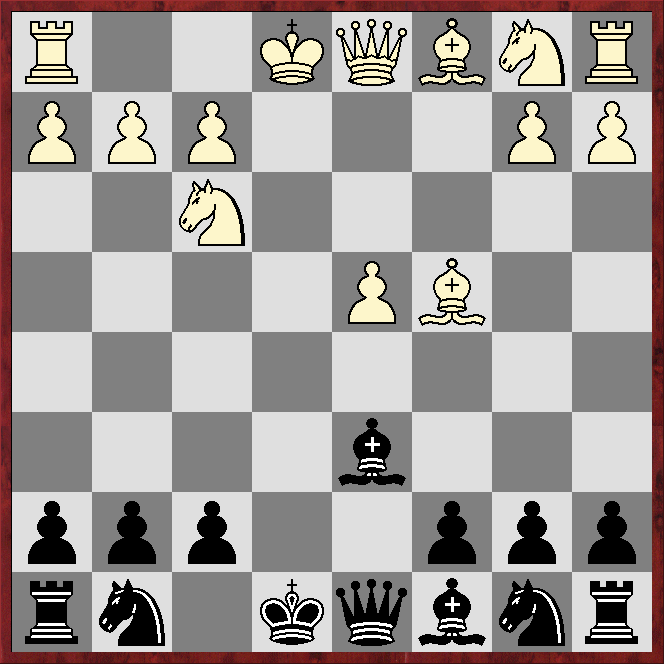Spanton (1931 ECF/1980 Fide) - John Cawston (1757 ECF/1776 Fide)
French Exchange
1.e4 e6 2.d4 d5 3.exd5 exd5 4.Nf3 Bd6 5.c4 dxc4!?
The usual advice in such positions is to wait for White to develop the king's bishop before capturing on c4. However many grandmasters have played the text.
6.Bxc4
*****
*****
*****
*****
6...Qe7+
Stockfish16.1 and Dragon1 slightly prefer 6...Nf6, which is the main move in ChessBase's 2024 Mega database.
7.Be3 Nf6 8.0-0 0-0
*****
*****
*****
*****
Clearly the pawn-structure is a major consideration, but for me it is impossible to say with certainty whom this favours. Both sides have developed three pieces, but the key factor here may be that the black queen is awkwardly placed on an open file,
9.Re1 Bg4!?
This sets a little trap, in that 10.Bg5? Bxf3 gives Black at least equality.
10.h3 Bh5 11.Nc3 Nbd7?!
The engines prefer 11...Qd7!?, albeit awarding White at least a slight edge.
12.Bg5 Qd8 13.g4!?
This is always a double-edged move in such positions, but here it seems strong.
13...Bg6 14.Ne5
*****
*****
*****
*****
14...Kh8
This unpins the f7 pawn, but the engines slightly prefer a move such as 14...Bb4!?
15.Nd5
15.f4 was still strong.
15...Bb4??
A ridiculous blunder. but Black has huge problems anyway. Perhaps the best suggestion from the engines runs 15...Nb6 16.Nxb6 axb6 17.f4, with an advantage they reckon is worth about 2.5 pawns.
16.Nxb4 1-0



I've been playing the French exchange with c4 for 25 years. In my view a key point is that White should retain some degree of initiative. Positions where Black can post a secure Kinght on d5 is one approach, another is where Black sets out to win the d4 pawn. That's well known isolated pawn theory, do you blockade it or attempt to take it?
ReplyDeleteRdC
I guess Nimzowitsch's answer would be that first you restrain the dangerous convict, then you blockade him and finally you destroy him. In this game the IQP's lust to expand to d5 was not particularly relevant, but it supported a strong knight on e5 - a knight that could not be captured because the black king's knight was pinned against the queen by White's dark-square bishop, which in turn could not be challenged by ...h6 because the f7 pawn was pinned against the black king. All very positional, but then, as is often the case at club level, such factors became irrelevant thanks to a simple tactical blunder!
Delete